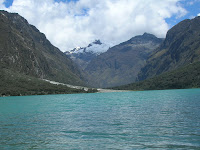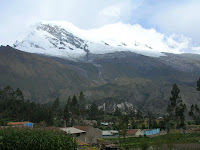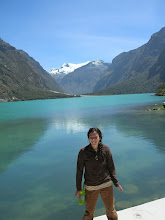My Thanksgiving was spent here in Huaraz also (my regional capital city) with about 10 other senior volunteers. We found a 20lb turkey in the market and paid a bakery to use their ovens to cook our beast. The baker gave us our turkey and promised that it was done, but it unsurprisingly had some pinkish raw spots that we decided to avoid for the sake of preventing any other parasitic friends that

would like to colonize our bodies. Another volunteer was sent a package full of Thanksgiving decorations, stove top, and cranberry sauce, so we all had some funny random pieces of Americana thrown into our celebrations. After our feast and tons of desserts, we went to a bar called the Old West, where the owner's brother in law is from Montana. The bar is full of trucker hats, American beer cans (but no American beer) and western memorabilia. In my merrymakings, I found a Sierra Forest Products hat, and was thrilled to tote it around for the evening. It was a wonderful place to end up at the end of Thanksgiving dinner.

This past week has been kind of difficult for me. In my first two weeks in site, my young host sister had been assaulted by a cab driver, and after taking her to the hospital my family had been in and out of the closest city (Yungay) to go to the police department and court and other such things. I am not really sure what happened or what is still going on, because everyone speaks Quechua, but I am just worried about my host sister and her well being. I am also doing the best I can to stay out of the way while trying to maintain and discover my place here, which has made things very difficult and very awkward for my first few weeks in site. Things seem to be calming down and everyone seems in good spirits, so I hope everything will work out soon and my family can relax. On top of all of that, I have had my first parasite, Giardia. I treat every drop of water that I drink, I am moderately careful with my food and I dont pick up piles of dirt and eat them, but the beauty of the Peace Corps is that we will be getting these lovely friends of our gastrointestinal system frequently. For four days, I was restricted to my bed, and had a very difficult time eating, drinking or standing up for more than 5 minutes. My diet consisted of bread, oatmeal and oral rehydration salts (which are disgusting
). On my first morning of being ill, I went with my family to roof a house of one of our neighbors. During the roofing, the men work on the house and the women prepare food and drink for everyone present. The traditional meal during these gatherings is caldo de cabeza, from the sheep that had been slaughtered that week. Sitting at a table struggling to only drink water, I was faced with a large bowl of broth, head, tripes of different sizes and unrecognizable organs. I generally grin and bear it and eat whatever is placed in front of me here, but being sick and seeing that many stewed organs just made me feel worse. Yet, I was still very appreciative for their offer, and drank some of the broth.
During my days I have been trying to establish my presence with the local school, which has been a constant struggle as well. The school is soon to go on vacations for the next two months, therefore I am trying to get in to do summer classes or a summer camp program that is focused on environmental science, English (which I do not want to teach but there is a strong interest), and health sessions. The director of the school has been very difficult and unresponsive, yet I will continuously try to get a foot into the door and break some ground there. I am also contacting World Vision, an NGO that works in the area, to see if I can team up with them on their programs and have a time slot for my own sessions. We shall see, we shall see.
Another school that I have visited, Humacchuco, has been extremely responsive and very interested in inviting me to their school. Their school is very strongly focused on ecology and environmental science, so working here would be a great opportunity for me to teach environmental science sessions to a group of interested students. The school has been visited and funded by a Canadian doctor, who has pushed their environmental focus, and in 1996, donated a flock of sheep for the students. The students here shear the sheep, dye the wool with local plants and flowers, and sell handicrafts to the tourists that pass through our area. After visiting my school in Huashao and leaving cursing and stewing, I walked up to Humacchuco, and was met by a breath of fresh air and some seemingly great opportunities (I also found a 4 leaf clover before going into the school).
On some weekdays, I hike up to the park and meet with the guardaparques (park guards) to try to establish a presence in the park as well. My counterpart is the boss of this section of the park, but he is currently in Bolivia for a conference. Without him being here, there is not very much that I can do, except introduce myself to the other few people that work in the park. For all of Husacaran National Park, which has the largest concentration of tropical glaciers in the world and covers a huge area, there are only 12 park guards. Many of them work at the post of control near my community, because this is the main entrance way into this part of the Cordillera Blanca and is a huge starting point for many of the most popular treks here in Peru. Also, I just like coming to Laguna Chinancocha to sit and read a nice book, and relax for a bit. Good times.


On Friday, I came into Huaraz for a training class offered by SERNANP (servicios nationales areas naturales protegidas)which is the agency that manages national parks and reserves in Peru. The director from the school in Humacchuco and a science teacher from my school in Huashao joined me for the 10 hour course. The course was offered to all schools within the buffer zone of the Huascaran bioreserve, in order to include courses about park flora, fauna, management and general information. Because we all live within the bioreserve, this information is critical to the students and people of these communities, and not only will it increase local pride in their natural resources, but will also be a great educational tool to encourage land stewardship and sustainable environmental management. On another note, the national park service owns a spectacled bear suit, and since he is their mascot, one of the techs was dressed up and set out to dance in front of us to a jingle about the bioreserve. Because I was the only gringa among about 40 teachers, I was sent up to the stage to dance with the dancing spectacled bear. I still cannot dance cumbia, especially not in front of a huge group of teachers. Also, after our training course was finished, a group of school children were invited to present to us a puppet show about spectacled bears. I am very very happy that puppet shows are a big thing here, because I will surely funnel some of my environmental education abilities into some fantastic puppet shows. During the puppet show, we were treated to another person dressed as a spectacled bear, but this time it was a singing and dancing eight year old, and it was awesome.
I apologize if my English skills are getting progressively worse. I know they are, and it is most likely very evident here. My mind is a mixture of Spanish, Quechua and at times like these English, therefore my grammar is destroying itself. Enjoy the downward spiral of my linguistic skills as you continue to read in the future. Oh and Happy Holidays!!! Don't forget to keep those less fortunate in mind now and at other times of the year. There are always millions of local organizations collecting food and clothing for people in need in our areas in the U.S. Also, if you are sick of buying useless gifts for your friends, you can buy livestock for a family in a developing country for a small price, from a great organization. Here is the link http://www.heifer.org/site/c.edJRKQNiFiG/b.204586/















 alt=""id="BLOGGER_PHOTO_ID_5432513096133847122" />
alt=""id="BLOGGER_PHOTO_ID_5432513096133847122" /> alt=""id="BLOGGER_PHOTO_ID_5432513089810463698" />
alt=""id="BLOGGER_PHOTO_ID_5432513089810463698" />
